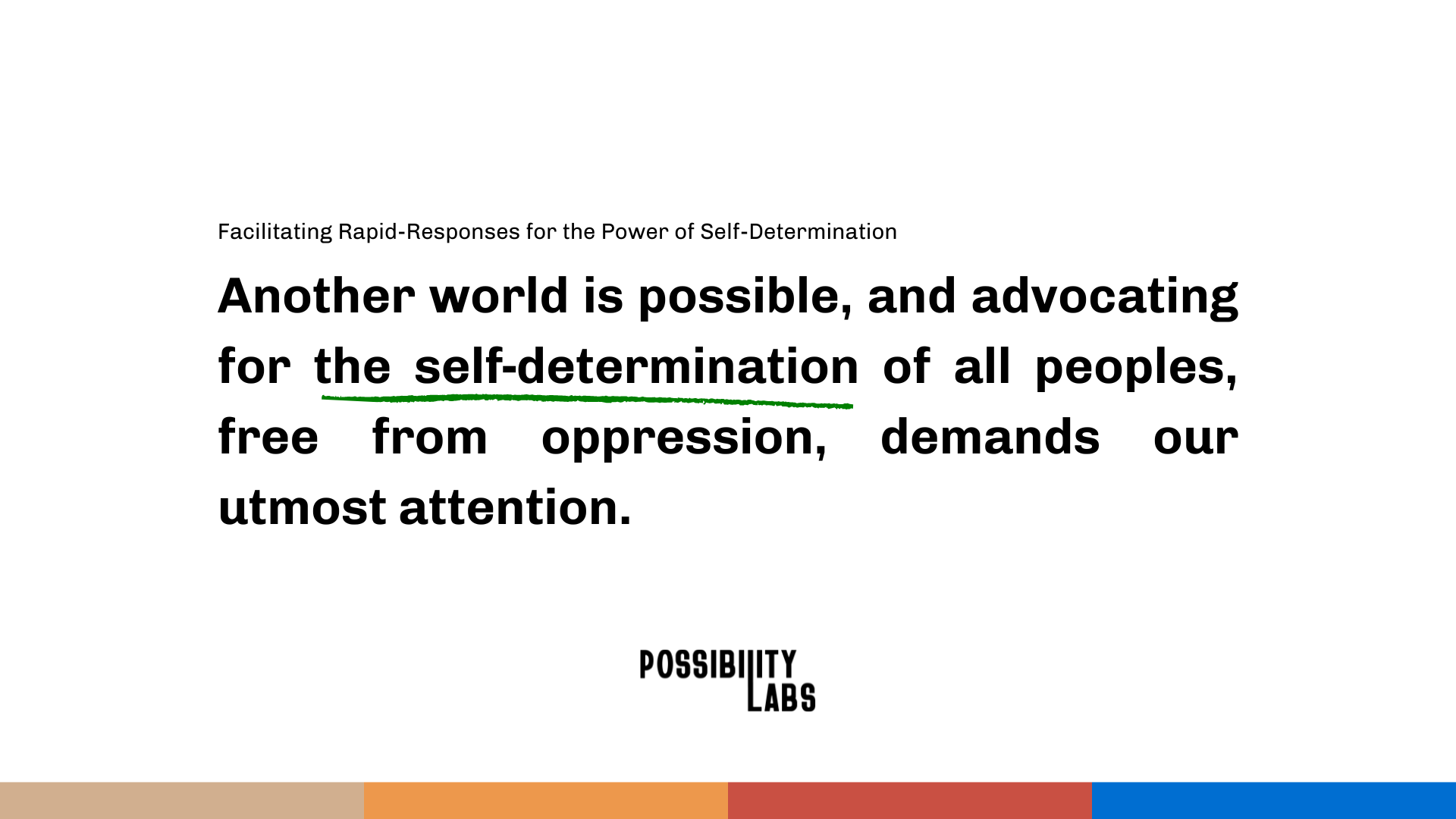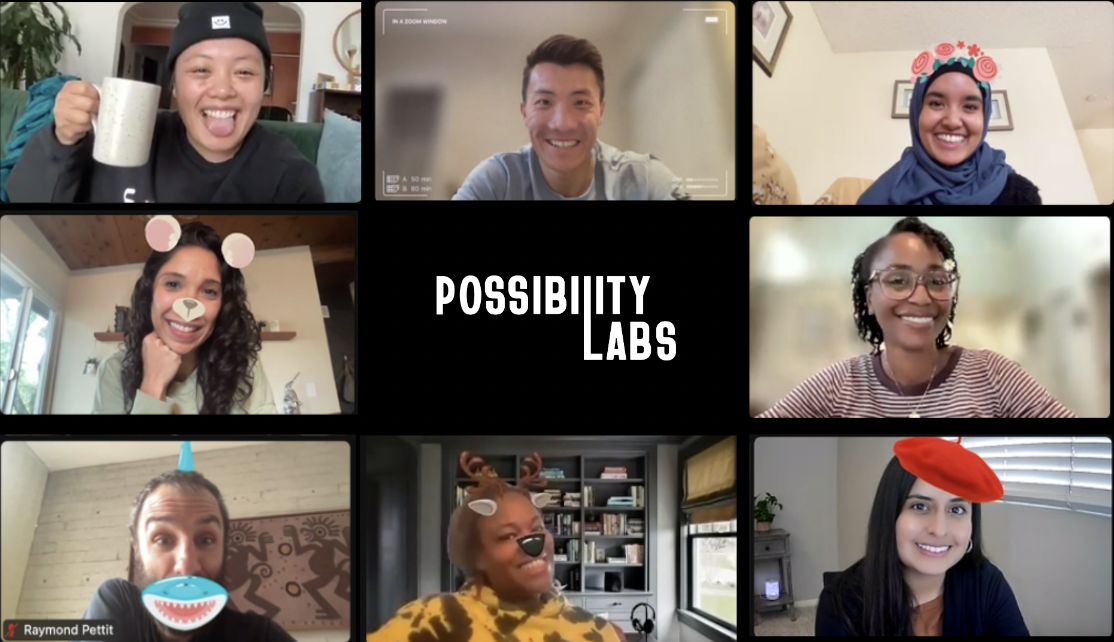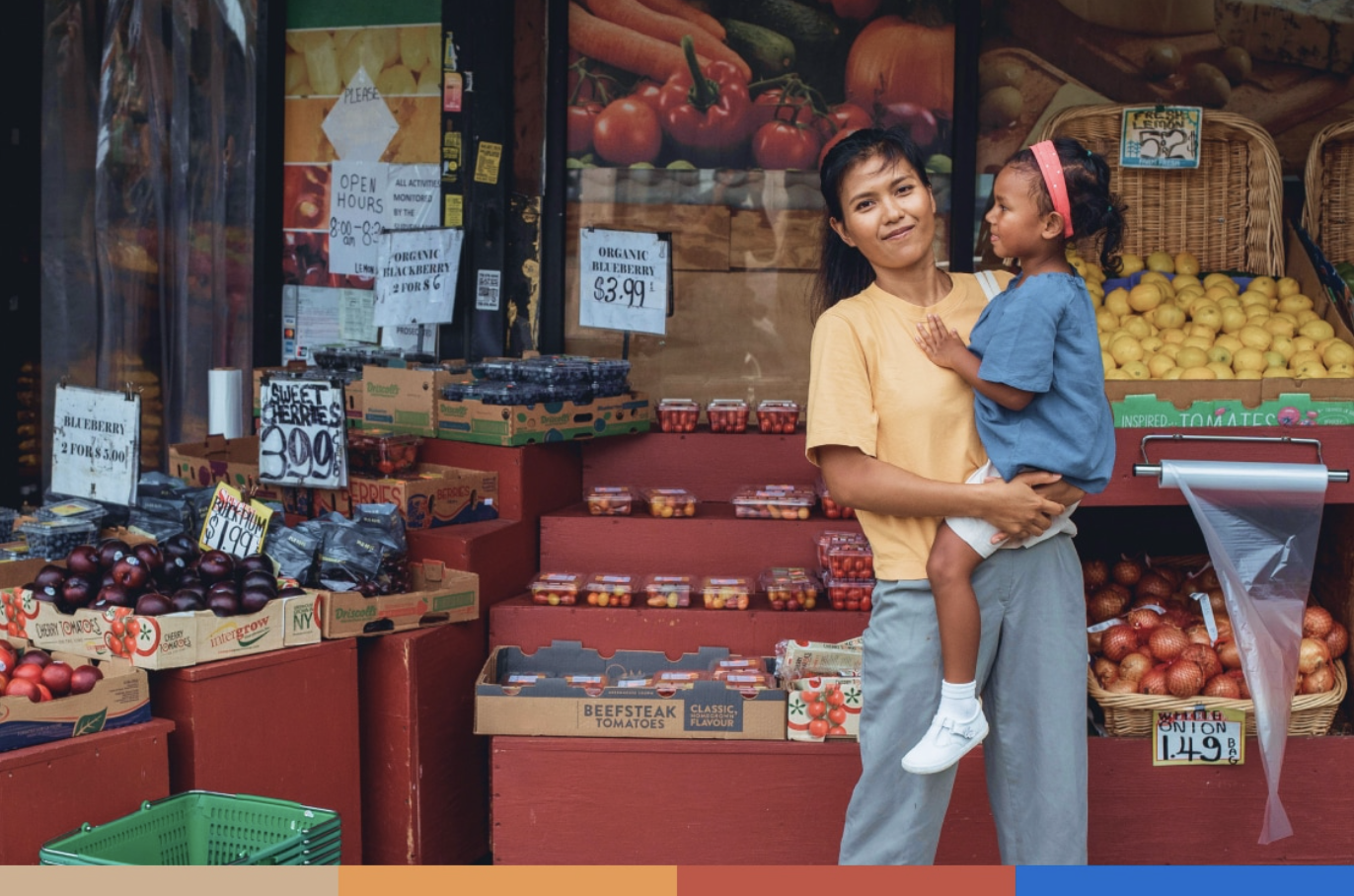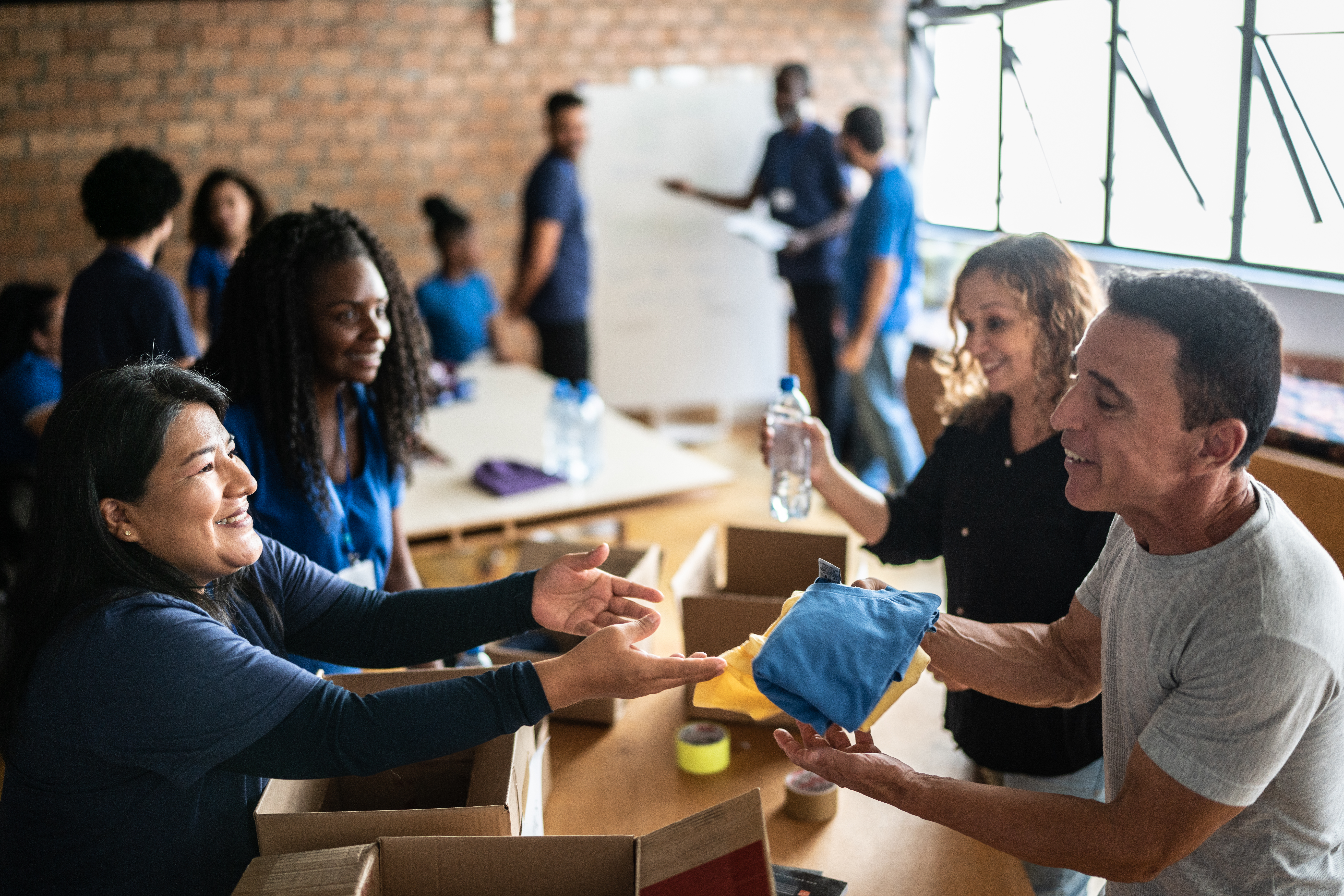Facilitating Rapid-Responses for the Power of Self-Determination
Possibility Labs’ mission is to support the economic approaches that help marginalized communities build viable livelihoods with dignity. We are compelled to address the stark reality that Palestinians face today: the economic limitations from the blockades coupled with the unconscionable levels of violence and denial of basic human rights amidst a humanitarian disaster undermine the very foundations of self-determination.
Another world is possible, and advocating for the self-determination of all peoples, free from oppression, demands our utmost attention.
With the compounding devastation that has come since October 7th, we grieve the horrific violence suffered by both Palestinian and Israeli communities, which has resulted in the deaths of over 20,000 people and the subsequent rise in anti-Palestinian, Islamophobic, anti-Jewish, and anti-Semitic rhetoric and hate crimes that have further exacerbated the deep wounds across the diasporas.
While the humanitarian truce was a brief reprieve and demands for a ceasefire continue, the fact still remains: it is impossible to live any kind of self-sustaining life in occupied Palestine.
Possibility Labs’ mission is to support the economic approaches that help marginalized communities build viable livelihoods with dignity. We are compelled to address the stark reality that Palestinians face today: the economic limitations from the blockades coupled with the unconscionable levels of violence and denial of basic human rights amidst a humanitarian disaster undermine the very foundations of self-determination.
If people cannot freely shape their own destiny and participate in their own governance, then the existing system is oppressive and must be uprooted so that all people can thrive.
In heeding the call from Palestinians to center their decades-long struggle for liberation, we stand firmly in solidarity for the self-determination of all Palestinians, and thus call for a permanent ceasefire, to secure the safety of all civilians and hostages, and to end Israel’s occupation of Palestine.
As a social justice intermediary at the nexus of movement builders and funders, we also remain focused on what we’re best positioned to do—to provide nimble infrastructure that facilitates rapid-response funding for organizations building solidarity across religion and race, safeguarding human and civil rights, and strengthening equitable media justice.
For values-aligned funders interested in directing resources, Possibility Labs is equipped to sponsor fiscal initiatives or host impact-forward Donor Advised Funds to streamline the flow of philanthropic capital to vital organizations that are engaged in this work, including those below:
- Adalah Justice Project
- American-Arab Anti-Discrimination Committee (ADC)
- Arab Resource and Organizing Committee (AROC)
- Council on American-Islamic Relations (CAIR)
- Helping Hand for Relief and Development (HHRD)
- If Not Now
- Islamic Networks Group (ING)
- Islamic Relief USA
- Institute for Middle East Understanding
- Jews for Racial and Economic Justice Community
- Jewish Voice for Peace
- Just Vision
- MPower Change
- Muslim Justice League
- Palestine Children’s Relief Fund
- Palestine Legal
- Palestinian Youth Movement
- Penny Appeal USA
- Rawa: Creative Palestinian Communities Fund
- Standing Together
- US Campaign for Palestinian Rights
- Within Our Lifetime
Likewise, for US-based power-building organizations and movement leaders, Possibility Labs offers fiscal sponsorship to help secure crucial grants that are essential for on-the-ground initiatives. While we can only support limited international grantmaking at this time, we are monitoring the evolving landscape to learn what capacities are needed to provide international support.
We hope to be one of many voices in the forthcoming and bellowing choir of change that will move the dominant narrative in the direction of justice. For the price of silence is far greater.
To a world where all people are free.
In solidarity,
Possibility Labs
An Open Letter: Navigating Change and Embracing Possibility
This an an Open Letter from the Possibility Labs team on reaching our three-year anniversary as newcomers. It’s been a rollercoaster to say the least, and we're not done yet. Read more on how we're navigating the next chapter with boundless hope and determination.
The start-up life...
…is a whirlwind of excitement, challenges, and growth. As we celebrated our three-year anniversary this past month, we found ourselves at a pivotal moment, and we wanted to share our story with all of you.
In our first two years, we witnessed incredible growth and celebrated significant milestones. We were the newcomers, carving a path with our passion to rebuild the exclusionary business constructs that charitable organizations were tethered to. In short order, we transformed an idea into a collaborative practice, working proudly with over 40 fiscally sponsored projects and donor-advised funds.
But let’s talk real for a moment—rapid growth isn’t always a smooth ride. It’s more like a rollercoaster, filled with twists, turns, and unexpected loops.
On one hand, we uncovered a profound insight—our partners embraced our “we’ll figure it out with you” approach to problem-solving with and for them. Whether it was revising HR policies for wellness stipends or enabling e-commerce capabilities, our solutions-oriented mindset opened doors to the seemingly impossible. And that was a breath of fresh air for our team and our partners.
On the other hand, on the back of this rapid growth and deep relationship building, we faced the very real possibility of stretching ourselves too thin. We needed to slow down and take stock of our strengths and weaknesses so that we could shift into being an institution representing a permanent asset for our communities. To prepare for the next stage of growth, our Board launched a comprehensive governance and operational review, examining every aspect of our organization: our finances, policies, procedures, client services, and structure. It became clear that managing growth demanded adaptability, resilience, and the courage to reevaluate our internal processes and realign strategies.
One of the unexpected challenges was losing our co-founders and co-CEOs, Keiko Murase and Lem White, who decided to explore new opportunities. During this time, we also realized that we could not build and pilot the solutions to the problems that we’ve identified as fast as we wanted to, and rather had to focus our strategies in order to have the most impact.
But here’s the silver lining—we’ve discovered the importance of strategic pause and transparent reflection to achieve financial viability—especially in the context of the unique challenges BIPOC organizations and businesses face.
Consider these sobering statistics, which highlight the disparate economic circumstances of communities of color which PL and its partner organizations work to redress compared to white-led organizations.
- Significant Revenue Disparity: according to a report by Echoing Green and the Bridgespan Group, early-stage Black-led nonprofit organizations face a 24% smaller revenue pool compared to white-led nonprofits. Furthermore, Politico also notes that this revenue disparity exists for private minority-owned businesses too—Black-owned small businesses earned 59% less and Latinx-owned small businesses earned 21% less in first-year revenues than their white-owned counterparts. Both reveal a substantial gap in financial resources available to organizations based on the racial background of their leadership.
- Stark Gap in Unrestricted Assets: The same Echoing Green and Bridgespan report indicates that the unrestricted assets for Black-led organizations are 76% smaller than those of white-led organizations. Unrestricted assets are crucial for organizational agility and long-term sustainability.
- Rigorous Funding Scrutiny for BIPOC Leaders: the Stanford Social Innovation Review highlights that nonprofit leaders of color experience higher levels of scrutiny and skepticism from funders compared to their white counterparts, suggesting an implicit bias in the funding process.
Steering the Ship
Embarking on the journey to “steer the ship” while maintaining our commitment to our partners raised some pivotal questions: how do we navigate temporarily without a captain? Who will provide the guidance needed as we course correct? And how can we make sure we’re getting to where we and our partners need to be?
As an interim solution, we’ve opted for a more distributed advisory model called the “Office of the President.” This dedicated team, composed of experienced industry leaders, Board members, and staff, will oversee daily operations, shape our future strategy, and lead the nationwide search for our next CEO.
- Mark Watson (he/him), Board Chair, is a visionary leader with over 30 years of experience in finance and innovative community- and impact-driven funds. He is the Co-founder and President of Potlikker Capital, a pioneering integrated capital fund dedicated to championing BIPOC farmers at the nexus of racial and climate justice.
- Jill Smith (she/her), VP of Operations, is a dedicated social justice professional with over a decade of experience in business and program operations, driven by a commitment to fostering positive change within historically marginalized communities. With a robust background in nonprofit work, she has excelled across various domains, showcasing her expertise in program development, operational management, and people operations.
- Jackie Khor (she/her), Senior Advisor, is an experienced leader at the intersection of impact investing and philanthropy, bringing over 30 years of expertise in leading teams and structuring multi-faceted investments across the philanthropic and impact investment spectrum.
- Jeff Malloy (he/him), Senior Advisor, has been appointed Treasurer of Possibility Labs. Jeff is a widely recognized leader in Finance and Administration in the nonprofit and philanthropy sectors. He has over 30 years of experience driving non-profit and corporate management excellence across Finance/Accounting, Human Resources, Operations, Technology, Risk Management, Grants Administration, Legal, and Compliance. He currently serves as President of the Foundational Financial Officers’ Group, a non-profit membership organization of financial and investment officers of large private foundations in the United States and abroad, and was previously Chief Operating Officer and Treasurer at the Heising-Simons Foundation.
- Kelley Buhles (she/her), Senior Advisor, is a collaborative leader, facilitator, and co-creator of new finance and governance models that center community wealth building and collective decision making. Kelley brings 15 years of experience with Donor Advised Funds, philanthropy, and integrated capital. Previously, Kelley worked at RSF Social Finance where she co-created the integrated capital approach to financing, participatory grantmaking programs, and oversaw the Donor Advised Fund program
- Lucas Turner-Owens (he/him), Senior Advisor, is a passionate impact investor and advocate for sustainability and economic justice with a diverse background spanning venture capital, impact consulting, and community-driven initiatives. He is the Founder of The Sankofa Group (TSG), a mission-driven advisory firm for impact investors and emerging managers.
The possibilities ahead are still abundant...
Our mission remains unwavering: to empower underinvested communities, supporting their resilience and self-determination. But the ways we achieve this mission are abundant. Our commitment to sound nonprofit corporate governance and uplifting the BIPOC and marginalized communities we serve remains steadfast and we will continue to lean into our framework of possibility and trust for our partners. The staff remains dedicated to empowering our partners through thought-partnership and creative solutioning to bridge the wealth, resource, and infrastructure gaps felt by many BIPOC movement leaders. But we’ve never been alone on this journey.
We extend our heartfelt gratitude to our core funders: the Kataly Foundation, The JPB Foundation, The Nathan Cummings Foundation, and the W.K. Kellogg Foundation for their recent support and continued belief in our mission.
Solidarity within our community has also been a beacon of hope. As Nwamaka Agbo, CEO of the Kataly Foundation, aptly puts it…
“At the Kataly Foundation, we are committed to resourcing initiatives that support the political, economic, and cultural power of Black and Indigenous people, and all communities of color. Possibility Labs’ mission aligns closely with our belief in community-driven economic development and systemic change. We are proud to support their work as they continue to build innovative infrastructure that is direly needed for our communities.”
And to you…for reading this far. Thank you. Your empathy, partnership, insights, and suggestions have been invaluable to us as we embark on this new phase for Possibility Labs. While we have some important mile markers to reach in front of us, including board expansion, business plan refinement, and the evolution of our leadership structure, we welcome your thoughts and feedback. Our inbox is open 24/7 at [email protected].
We’ll also be updating on our progress more regularly via posts like these and via email.
Your continued support and commitment to our shared vision are deeply appreciated. Together, we are not just building possibilities; we are building a brighter and more innovative future.
With boundless hope and determination,
The Possibility Labs Team
Anika Akhter, Chanell Gore, Cindhy Soto, Daniel Zhou, Jaimee Estreller, Jill Smith, Khalid Kadir, Mark Watson, Randall Huerta, Raymond Pettit, and Rosemary Fei.
Community Ownership: How Reimagined Economic Development Can Build a More Equitable Future
What is community ownership, and how can investing in it help bolster local communities and create a more equitable future?
From sharecropping to redlining to urban neighborhood disinvestment, control over property ownership has been a tool used to oppress Black and Brown communities throughout the United States’ history. As decades and generations of systemic oppression have converged, it’s going to take bold new strategies — ones that place people firmly before profit — to begin reversing historical harms and building a more equitable future.
Community ownership isn’t a new concept, but it’s one that’s gaining more and more traction as housing and property prices soar out of reach for so many people — especially Black, Indigenous, people of color (BIPOC) and historically low-income communities. With a variety of potential models and the growing number of success stories, it’s one way community builders and changemakers are accelerating progress toward building just, self-determined, and regenerative local economies.
What is Community Ownership?
On its face, community ownership is a simple idea.
“Community ownership” refers to a model of collective ownership and management of resources, assets, or services by a community or group of individuals who live or work in a particular area.
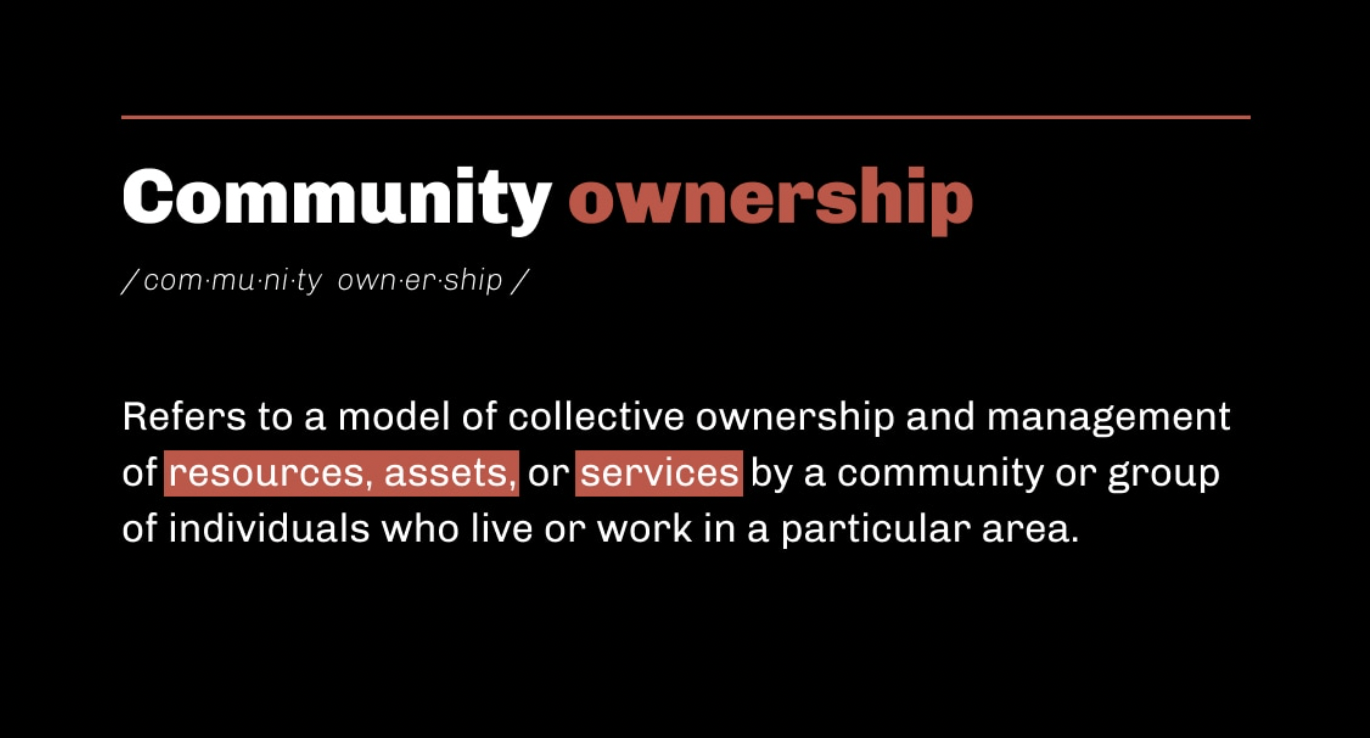
In this model, the community members have a stake in the ownership and decision making of the resources, which may include land, buildings, businesses, or other community assets. Community members collaborate and participate in management and governance processes, with the goal of improving their social and economic well-being and maintaining the sustainability of their shared resources.
Community ownership can take many forms, but the underlying principle is that the community members have a shared sense of responsibility for the assets and resources that they collectively own, and work together to achieve common goals and values.
One common type of community ownership in the U.S. is community ownership of land or real estate property.
As Brookings Institute researchers Tracy Hadden Loh and Hanna Love have noted, defining this kind of community ownership in practice can be difficult. They’ve identified four questions that can help define the concept:
- What are the goals of community ownership? By definition, community ownership exists for the “common good” of the community, but how “common good” is defined varies, and can help define the model of community ownership.
- Who is the “community”? The definition of community varies, and can be as large as an entire city or as small as a single neighborhood or building.
- Who “owns” the property in community ownership? Community ownership still needs to fit under existing laws and regulations, which means that someone has to actually own the community’s resources. How ownership is divided and earned varies based on the model of community ownership at play.
- How do individual wealth and community ownership intersect? Community ownership doesn’t necessarily mean that individuals give up all of their own property rights, but this varies depending on the model of community ownership — which also helps determine the balance between community and individual rights and responsibilities.
The History of Community Land Ownership
Community ownership has a long history around the world. One of the earliest examples is in India, where land was held as common property among tribes until around 1500 B.C.E. In North America, Mexican ejidos, or “village lands,” were formally established in the 1920s — but long before that, they existed as a traditional indigenous system of land tenure where collectively owned parcels were worked by tenants.
The history of community ownership of land and real estate in the United States can be traced back to indigenous land stewardship practices. These practices continued post-colonization in the 1700s, when utopian communities and cooperative societies emerged. The Shakers, for example, established communal farms and villages in the 18th and 19th centuries, where land was owned and used collectively. Similarly, the Oneida Community, founded in 1848 in upstate New York, was a utopian society that shared land and resources in a communal manner.
In the late 19th and early 20th centuries, land trusts and mutual housing associations began to emerge as vehicles for community ownership. The National Housing Act of 1934 also provided funding for the creation of community land trusts, which allowed communities to own and manage land for affordable housing.
Community land trusts gained even more traction in the 1960s South amid the Civil Rights movement. One of the first organized examples of BIPOC community ownership was New Communities Incorporated, a community land trust established in Lee County, Georgia in 1969. The trust gave Black farmers collective power to fight back against discrimination, predatory lending, and agricultural industrialization that prevented them from securing land. In the next decade or so, community land trusts became a more common way for historically oppressed communities to combat racist lending practices and major industries, like timber, who fought to control vast swaths of rural America.
In the 1970s and 1980s, limited equity cooperatives also became popular as a form of community ownership. These cooperatives were typically created by tenants who purchased their buildings from landlords, often with the help of government financing. Unlike market-rate cooperatives, which allow for resale at market value, limited equity cooperatives limit the resale value of units in order to maintain affordability for future buyers.
Throughout the 20th century, other models of community ownership have emerged, such as community development corporations (CDCs), community benefit corporations (CBCs), and community foundations. CDCs were first established in the 1960s as a response to the lack of investment in low-income urban communities. These organizations are typically non-profit entities that engage in a range of community development activities, including affordable housing development, commercial development, and neighborhood revitalization. CBCs are for-profit entities that are dedicated to using their business operations to achieve social or environmental goals, such as sustainable agriculture or renewable energy development. Community foundations are non-profit organizations that pool charitable donations from individuals and organizations in order to make grants to support community development.
Despite the long history and diversity of community ownership models in the United States, the scale of community ownership remains relatively small compared to traditional models of ownership. Structural racism, discriminatory policies and practices, and market pressures have all been barriers to the widespread adoption of community ownership models. However, in recent years, there has been a growing interest in community ownership as an intersectional approach to advancing holistic solutions, such as affordable housing, community wealth building, community organizing, climate resilience, racial justice, economic mobility, and equitable food access.
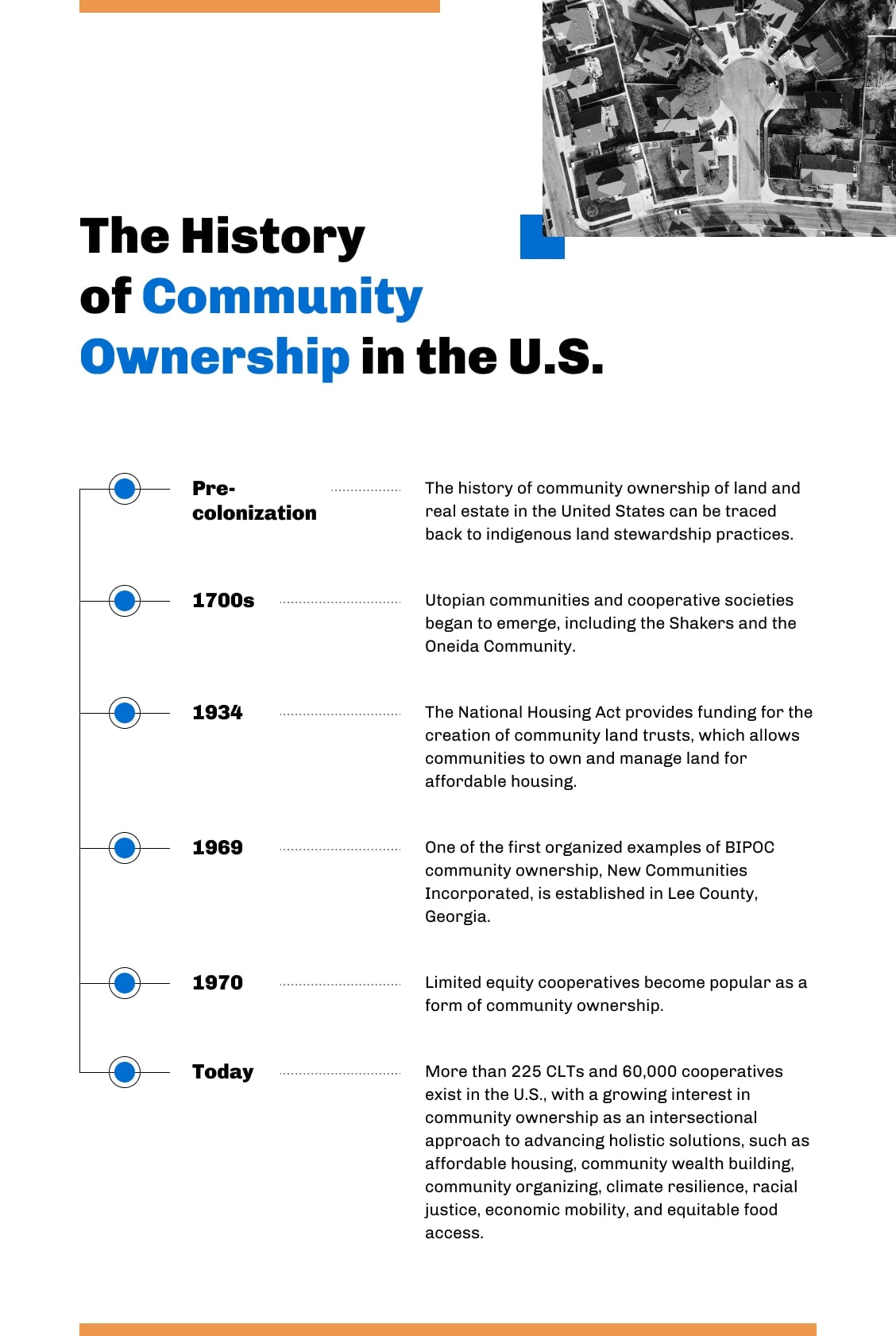
A Snapshot of Community Ownership in Action
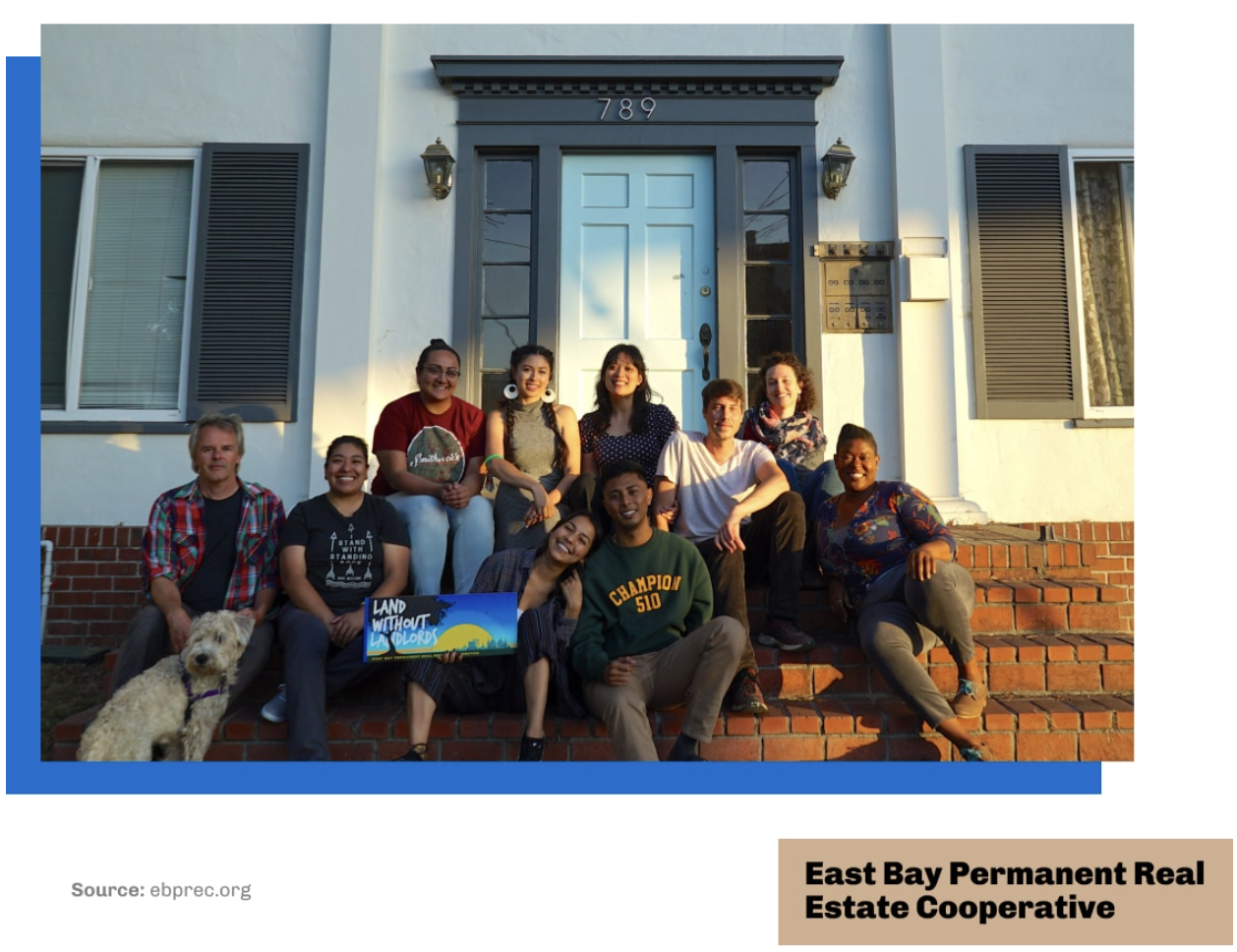
The East Bay Permanent Real Estate Cooperative (EB PREC) is a cooperative corporation located in California. The cooperative raises capital through investments and membership shares, which are sold for $1,000 each. The capital is used to purchase properties in Oakland and the East Bay.
Members who are residents in EB PREC’s properties secure long-term leases through monthly payments. EB PREC sets minimum standards for maintenance, but most property decisions are made democratically by residents. Residents can sell their leases for a modest return tied to the Consumer Price Index, plus compensation for any improvements they’ve made.
The result is housing that’s co-owned and co-stewarded by resident homeowners, investors, community members, and EB PREC staff. EB PREC provides training to residents in how to manage their homes without landlords. For every property EB PREC buys, community housing is removed from the speculative market, protected, and reserved to help disenfranchised community members preserve affordability, build community wealth, and reinvest in their own community.
Today, the East Bay Permanent Real Estate Cooperative owns three properties that provide permanent, affordable housing for BIPOC residents, working artists, art educators, and other “culture-keepers” in the community.
The Breadth of Community Ownership Models
Community ownership today comes in many forms, including coops, real-estate investment trusts, community-owned stores, and more. Some of the most common models of community ownership are below, and is an ever-evolving list as the sector continues to grow.
Cooperatives
Cooperatives are businesses or housing owned and stewarded by their members. They can take many forms, including consumer cooperatives, worker cooperatives, and residential cooperatives. The members of a cooperative share in the decision making of the property or business, and often work together to provide goods and services to their community of owners.
Ownership:
In a cooperative, ownership is vested in the members of the cooperative, who are also the customers, employees, or residents of the cooperative. Members typically have an equal say in choosing leadership, though the majority of cooperatives do not have direct member governance (consumer cooperatives, credit unions, or electric cooperatives, for example). Unlike traditional corporations, cooperatives are not owned by external shareholders who are seeking to maximize their profits.
Financing:
Cooperatives can be financed through many different means, including member equity, loans, and grants. Members may invest capital in the cooperative, which allows it to purchase assets or make improvements. Members may also provide loans to the cooperative, which can be repaid with interest.
Governance:
Cooperatives are democratically governed, with each member having an equal vote in the decision making process. Typically, cooperatives have an equal vote for determining leadership, but this can depend on the structure of the cooperative; for example, some have uneven voting representation to prioritize local voice if there is a mix of local shareholders and consumer shareholders. The board is responsible for setting policies and overseeing the management of the cooperative. In some cases, cooperatives may also have committees or working groups that are responsible for specific areas of governance.
Community Land Trusts
Community land trusts (CLTs) are non-profit organizations that hold land for the benefit of a local community. They can be established for residences, commercial property, or both.
Ownership:
In a CLT, the land is owned by the CLT itself, while individual community members own the buildings and improvements on the land. This separation of ownership ensures that the land remains in the public trust and is not subject to market speculation or gentrification. The CLT’s ownership of the land is typically perpetual, meaning that the land is held in trust for future generations.
Financing:
CLTs can be financed through avenues like grants, donations, and loans. Because CLTs are non-profit organizations, they are not focused on generating profits for shareholders or investors. Instead, they are focused on providing affordable housing or preserving, protecting, or producing open space for the benefit of the community. This mission-driven approach can make it easier for CLTs to secure funding from government agencies, philanthropic organizations, and socially responsible investors.
Governance:
CLTs are democratically governed by a board of directors, which is typically made up of community members and stakeholders. The board is responsible for setting policies and overseeing the management of the land held by the CLT. Because CLTs are community-led organizations, they often have strong community engagement programs that involve community members in the decision making process. They also often have a requirement about community representation on the board of directors.
In addition to democratic governance, CLTs are guided by a set of principles and values that emphasize community control and stewardship of the land. These principles include community control of the land, democratic decision making, long-term affordability, and sustainable development.
Community Development Corporations
Community development corporations (CDCs) are non-profit organizations that are focused on community economic development.
Ownership:
CDCs do not have a standard ownership structure in the traditional sense. Instead, they are community-based organizations that are focused on serving the needs of the community. CDCs may engage in a range of activities, including affordable housing development, small and local business support, and community revitalization initiatives.
Financing:
CDCs can be financed through a variety of means, including grants, donations, loans, and tax credits. Because CDCs are focused on community economic development rather than generating profits, they often have access to funding sources that are not available to for-profit businesses, such as government agencies, philanthropic and advocacy organizations, and socially responsible investors.
Governance:
CDCs are governed by a board of directors, which is typically made up of community members and stakeholders. The board sets policies and oversees management, with involvement from community members in the decision making process.
CDCs also follow principles and values that emphasize local ownership and control of resources, community participation in decision making, community-based economic development, and social and economic justice.
(for more examples of emerging Community Ownership models, check out this report from Kresge Foundation)
Benefits of Community Ownership
In the different models of community ownership, there’s one common thread: They share the core principle of community control and decision making over assets or resources. They’re all designed to ensure that resources are owned and managed by members of the community, rather than by individuals or corporations who may not have the community’s best interests in mind.
Studies of community ownership models over time have identified a number of benefits that provide evidence for the effectiveness of community ownership in bolstering local economies, building generational wealth, and protecting communities and the environment.
Economic Benefits of Community Ownership
The research is strongest in the area of economic benefits of community ownership.
Community ownership models have been found to enhance retention for homeownership, especially for low-income buyers. For example, CLTs help reduce mortgage foreclosure and prevent the loss of household wealth by having a third party that stands between the owners and lenders, reviews and approves proposed mortgages to prevent predatory terms, and seeks to support owners if they get behind in their payments.
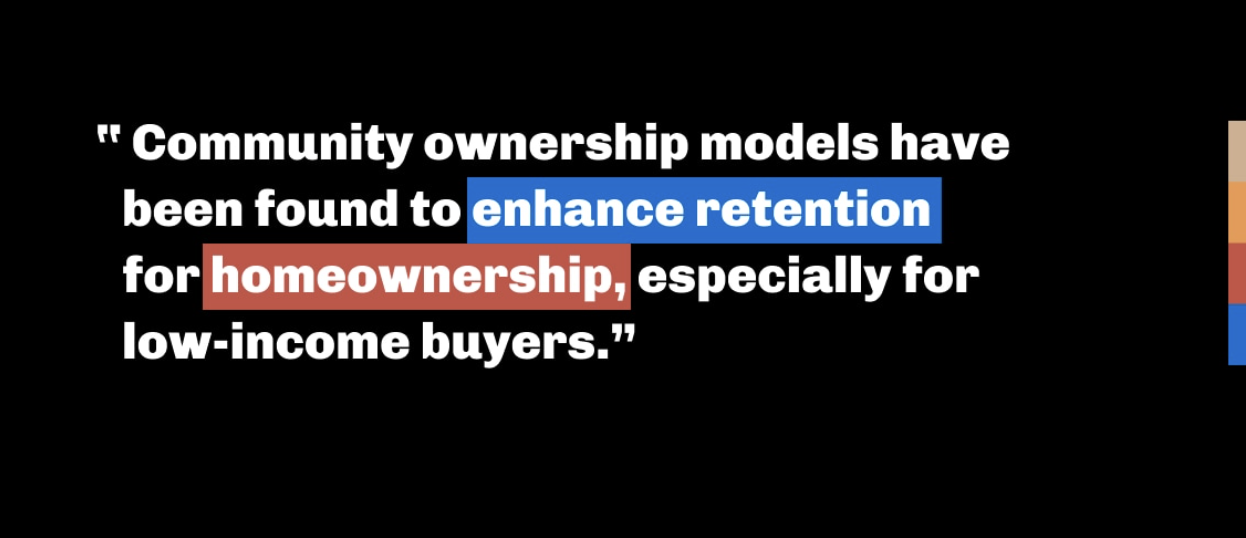
Community ownership models also help close the racial wealth gap by distributing land-based wealth intergenerationally, especially in predominantly Black communities where assets are undervalued. In terms of small business development, community ownership models reduce barriers to entry by preserving low-cost retail spaces and bringing capital investments into communities to address commercial needs.
Lastly, community ownership models bring economic benefits to state and local governments in weaker markets by reducing vacancies, strengthening ‘community curb appeal’ and making more efficient use of existing infrastructure.
Civic Benefits of Community Ownership
In addition to the economic benefits, community ownership has been found to have a number of important civic benefits that help build strong communities.
Community ownership models often rely on the active participation of community members in decision making processes, building increased civic engagement and political power where generations of white supremacy, systemic racism, and economic injustice have shut Black, Indigenous, immigrant, and people of color — as well as other marginalized communities including disabled folks, working people, and LGBTQIA+ people — out of being able to shape city, county, and state laws and institutions.
Community ownership exists to serve the “public good” of the community, which gives all residents and stakeholders an active role in the stewardship of shared assets like parks and community centers. Research shows that this can inspire residents to organize for additional collective infrastructure, public spaces, health and wellness, and other shared goals that will help the community thrive.
Social Benefits of Community Ownership
Because community members are involved in decision making in virtually every model of community ownership, these models naturally foster social cohesion and a sense of belonging among residents and neighbors. They can also help reduce disparities in access to resources and opportunities, particularly for historically marginalized communities.
This leads to greater local control over resources and governance, enabling communities to prioritize their own needs and values with equity and sustainability at the center of their practices.
What's Holding Community Ownership Back?
Despite all the benefits, community ownership still faces challenges and roadblocks. Both policy and structural barriers prevent more widespread adoption of community ownership nationwide.
Access to Capital
One of the largest barriers is access to capital. Community ownership often requires significant liquid, upfront capital for land, buildings, renovations, and conversions. Access to financing can be a major challenge for communities that lack wealth or connections to financial institutions.
Even when capital is available, mission-driven investors and organizations aren’t always compatible with the pace of real estate deals. Real estate sales transactions average about a month in length, which isn’t always enough time to assemble capital from sources like philanthropy and grants, which simply aren’t designed to move that quickly.
Regulatory Barriers
Another major challenge is barriers in systemic and regulatory processes that aren’t historically designed for facilitating community ownership.
There is a lot of government funding for affordable housing in the U.S., but it tends to favor developers working within specific approaches — for example, new construction and multifamily rentals with high numbers of units. Existing models of community ownership don’t easily fit this profile, so they can’t easily access available funding — which limits their ability to grow.
There’s also the levels of oversight and regulation that different community ownership models must adhere to. Community land trusts are defined in federal law, but many of the newer, emerging financial models for community ownership are subject to state regulations or the SEC, where many regulations are designed to protect investors, which is antithetical to the governance goal of community ownership. Investors are typically primarily concerned with maximizing financial returns on their investments. They are motivated by profit and may prioritize short-term financial gain over the long-term well-being of the community. This is especially true in the case of outside investors who do not have a direct connection to the community in which they are investing.
Additionally, investors may have different priorities and values than the community. For example, investors may prioritize economic growth and development over environmental concerns or social justice issues. They may not consider the impact of their investments on the community’s quality of life or cultural identity. Investors may also have different time horizons than community members, as they may be looking to exit their investment in a relatively short period, while the community has a long-term interest in the health and sustainability of the assets they own.
Limited Access to Expertise
In community ownership models, community members work with funders, investors, and other activists who use different strategies, tactics, tools, and vocabulary. Sometimes even getting every stakeholder aligned can be a significant barrier.
Community ownership also can require a high degree of expertise in fields such as finance, real estate, and law. Not all communities — especially those that have been historically disenfranchised — have access to the necessary expertise.
Structural Racism
Structural racism has been a significant barrier to community ownership by creating and perpetuating systemic inequalities that have limited access to wealth, resources, and opportunities for communities and people of color.
Systemic racism bleeds into and affects all other barriers to community ownership; for example, racial bias and discrimination have impacted the ability of communities of color to access funding and resources needed to start and sustain community-owned businesses and organizations. Black and Brown communities have historically been labeled as “high risk” by lenders and financial institutions due to systemic racism and biases. This perception has resulted in limited access to financial resources, making it difficult for these communities to secure the capital needed to start and sustain community-owned businesses and organizations.
How Possibility Labs Addresses Barriers to Community Ownership
At Possibility Labs, we support community ownership as an essential means for our communities (and individuals in those communities) to own and self-govern our own assets so we can determine our own futures. We believe that this leads to a regenerative local economy with better paying jobs, locally owned businesses, and community-owned housing.
Possibility Labs can help community changemakers interested and invested in community ownership accelerate their progress. We also help foundations, donors, philanthropists, and other stakeholders amplify their impact via community investments.
We do this in four main ways:
- Capital and growth services: We offer fiscal sponsorship, resourcing, and hosted fund capabilities as well as community-driven investment vehicles such as Donor Advised Funds that make it easier (and faster) to deploy and manage flexible, integrated capital, including multi-year grants, recoverable loans, and recoverable grants, to name a few.
- Strategic advising: We can advise on entity structures, financial and legal compliance, information and operation infrastructure, fund design, and investment strategies to help changemakers design and implement custom solutions that fuel growth in their unique communities.
- Modernized data management: We offer a cohesive tech stack in an all-in-one portal that helps bring community focused organizations into the digital age.
- Community learning: We help build cross-sector relationships and facilitate networks for support, learning, accountability, and expertise so changemakers can align and connect with a diverse ecosystem of knowledge and skills.
Possibility Labs focuses on operationalizing multi-entity solutions advancing social, climate, gender, racial, and economic justice. Discover what’s possible with Possibility Labs: Schedule an introductory conversation with a member of our team today.
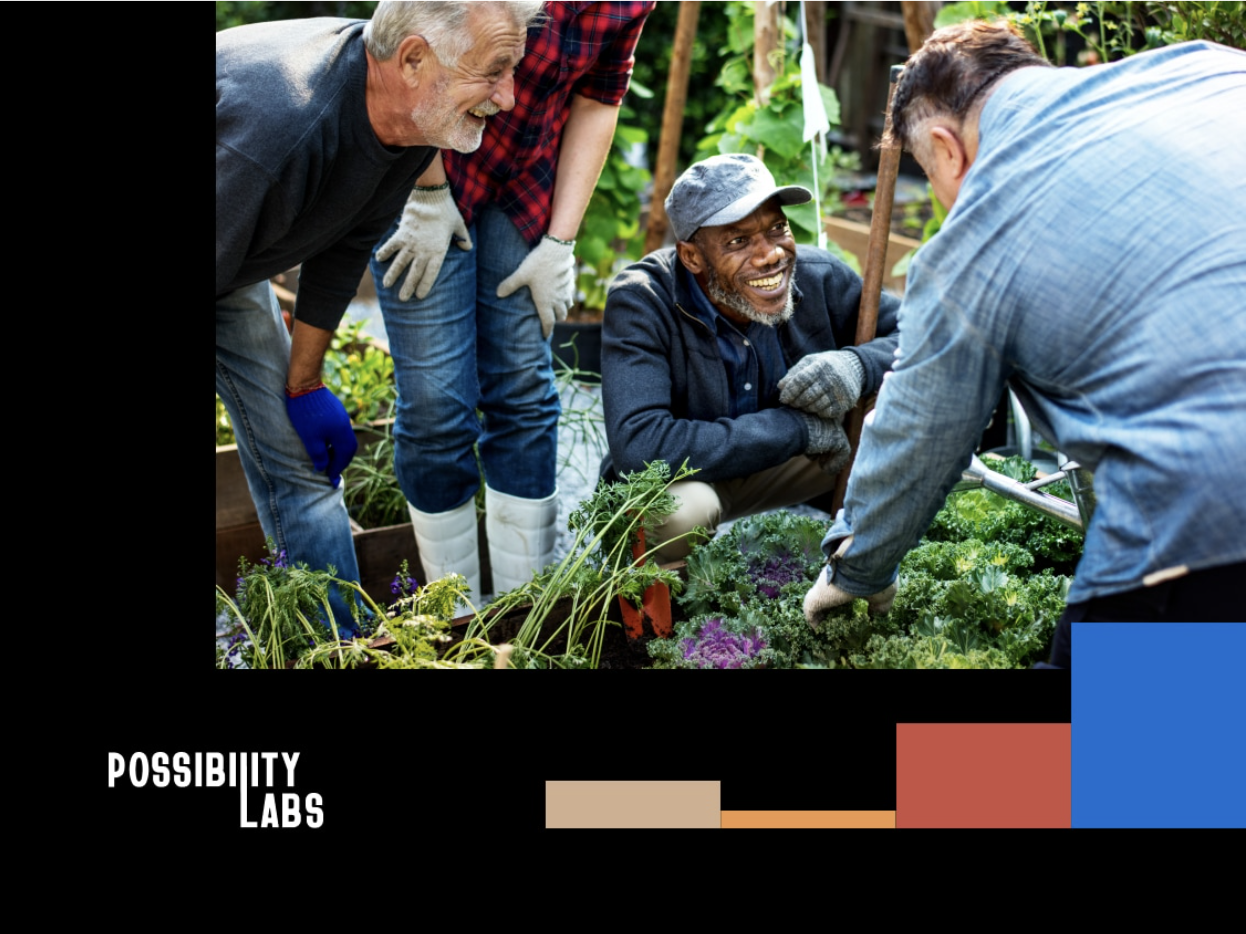
From #GivingTuesday to #BuildingCommunityPower
Every dollar from #GivingTuesday goes a long way for savvy social changemakers on the ground, but the bigger need that centers movements is for donors to shift and expand their giving by investing catalytically too.
Fund social changemakers through one-time donations and/or sustained catalytic impact investing.
For trailblazing nonprofits piloting new economic models in our communities, #GivingTuesday is an important fundraising milestone to garner year-end donations of all sizes from folks who want to intentionally spend with impact. On the flip side, #GivingTuesday is a singular time-bound day following the seasonal frenzy of buying spurred on by Black Friday, Small Business Saturday, and Cyber Monday.
As we know, long-term community power building needs more than just one day of giving.
Shifting from a giving mindset to an investing one means actively moving resources that enable the power of self-determination for recipients: with speed, with trust, without restrictions, and through a variety of wealth-building capital such as multi-year grants and recoverable loans.
Below are two ways to support our diverse community of changemakers: through donations or by opening a Donor Advised Fund at Possibility Labs for sustained catalytic investing.
Support a Few of Our Community Partners
Advance Climate and Social Justice Solutions
- Taproot Earth: a new organization building power and cultivating solutions among frontline communities advancing climate justice and democracy. Your support helps advance climate justice from the Gulf South to the Global South through movement-building, law & policy strategies, global climate reparations, and equitable disaster recovery.
- Just Economy Institute: a community of financial activists who are shifting the flow of capital and power to help solve social and environmental problems. Your gift to JEI creates opportunities for fellows from all backgrounds to build a just economy.
Empower Family and Youth Wellbeing
- New Beginnings Support Services: an organization that provides access to resources, information, and support to empower and educate parents, engage communities, and uplift children impacting a positive future for Las Vegas families. Your contribution provides individualized case management support by promoting safety, good health practices, and a sense of well-being for children and parents.
- evolutionforward: an education fund dedicated to protecting and advancing the health and wellbeing of children due to systemic exclusion based on race, class, culture, geography, education, language, and other demographics. Your donation supports their three intergenerational areas of focus: babies & birth, children & education systems, and the promotion of non-violence in the U.S.
- Wild Awake: a social enterprise curating immersive, intergenerational outdoor learning experiences on Ohlone land that are rooted in connecting with ourselves and the more-than-human world. Your donation will expand their programs to more BIPOC low-income youth, including program and transportation costs for BIPOC youth and training BIPOC facilitators to lead programming.
Center Community Care, Solidarity Programs, and Thriving Spaces
- Indigenous Healing Center: a project located on unceded Coast Miwok traditional territories creating spaces for the practice, revitalization, and visibility of Indigenous cultures, languages, and life ways, with a focus on Indigenous medicine and healing. Your contribution aids in providing health services to Indigenous families in Marin County by creating spaces for the practice, revitalization, and visibility of Indigenous cultures, languages, and life ways.
- Vital Little Plans: an artist collective and giving circle that supports equitable, creative, and vital plans that are arts-driven and community-led for neighborhoods and places. Your donation helps them host a learning network for peers and provide technical assistance to projects.
- Cut Fruit Collective: a grassroots group for AAPI community care driven by art, community, and shared love of food. Your donations help them support AAPI artists, amplify AAPI activists, invest in vulnerable AAPI communities, and build coalitions across AAPI communities and beyond.
- Discover Community Café: a space to love, heal, dream, and belong that leverages the power of food to create transformational jobs for women, champion local entrepreneurs, and ignite connection for an inclusive local economy. Your donation will go towards an apprenticeship program, start-up costs, labor, food costs, rent, and licenses.
- LUNAR: a community building and investment vehicle for Asian-Americans to support the movement for Black and Indigenous-led liberation. Your investment supports their operations and seeds the LUNAR Fund where a portion of these funds will serve as matching funds for giving circles.
- BOYFRIEND CO-OP: a coffee and cocktail cooperative based in Ridgewood, Queens where queer and trans women and gender non-conforming people can feel safe, cultivate community, and practice cooperation. Your donation will cover crucial startup costs, such as business registration fees, attorney fees, and a liquor license with plans to open their doors in the summer of 2023.
- Radical Family Farms: a mixed-Asian regenerative, no spray farm that grows culturally relevant crops for the Asian diaspora and offers produce boxes, flower CSA programs, and solidarity shares. Your contribution supports food access and community supported agriculture (CSA) assistance, climate smart farming, and mentoring and training for AAPI, BIPOC and LGBTQIA+ folks on the farm.
- Just Love Collaborative: a bridge-building organization that supports cis and trans women and girls of color by providing holistic resources to fortify self-love and sustain a greater quality of life. Your donation helps with their identified programming: housing insecurities and barriers for Black and Brown women, health and wellness prioritizing fitness and nutrition, and small business development.
Champion the Visibility and Education of BIPOC Leaders
- Leadership Learning Community: a national nonprofit organization transforming the way leadership development work is understood, practiced and promoted, primarily within the nonprofit sector. All contributions will be used in the effort to grow their on-site base of blogs, events, and resources for systems change, expand outreach, to make Network Weaver more accessible, and fund the emerging Network Weaver BIPOC initiatives.
- REĀL: an association to increase visibility, advancement, and equity for Latinx professionals in commercial real estate at all professional levels and across industry sectors. Your donation supports their operations and initiatives, including mentorship and networking events.
Open a Donor Advised Fund at Possibility Labs
Donor Advised Funds (DAFs) began to grow in popularity in the 1990’s because they enabled donors to have the infrastructure of their own grant making foundation without all the upkeep. Through a Donor Advised Fund, donors can make charitable gifts to a sponsoring organization (like Possibility Labs) and then recommend how to redistribute those funds to organizations and movements.
By opening a DAF with Possibility Labs, donors can become co-creative partners investing in social justice and change in every aspect:
- We are the only DAF platform where all senior leadership is comprised of BIPOC individuals;
- We diversify the capital stack by deploying multi-year grants, recoverable grants, recoverable loans, and guarantees in ways that center community needs; and
- We require a 10% payout, incentivize 40% deployment, and invest 60-90% of remaining assets in BIPOC-led community wealth building activities such as cash deposits and municipal bonds.
- We can help move funds within 3-4 business days to local community groups or funds so donors can urgently respond to climate or humanitarian crises when needed.
By the end of 2022, our initial cohort of DAF partners are on track to deploy 60% compared to Fidelity’s own payout rate of only 22% and 27% over the past five years.
To learn more about our new kind of Donor Advised Fund, click here or contact Vanessa Huang, VP of Partnerships, at [email protected].
–
If you are interested in supporting Possibility Labs’ efforts in building community infrastructure for those co-creating a just economy, you can donate here or contact Melissa Peña, Philanthropy Manager, at [email protected].

